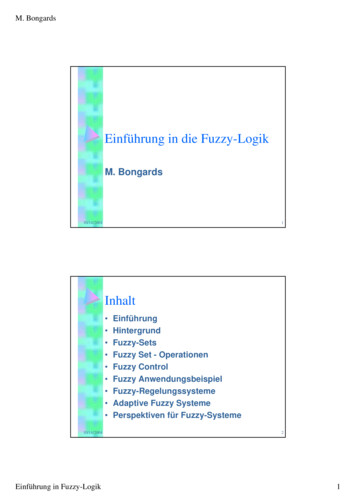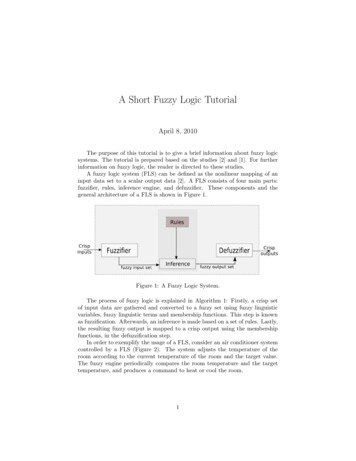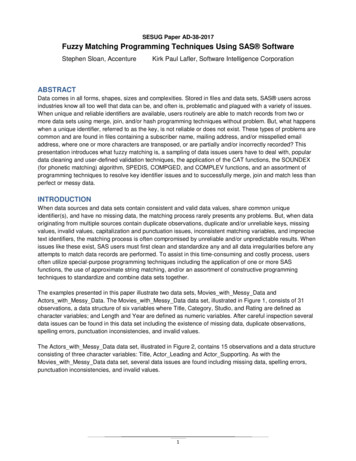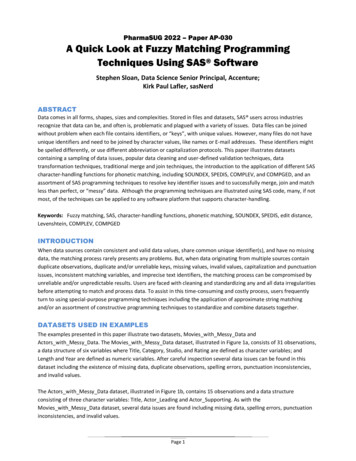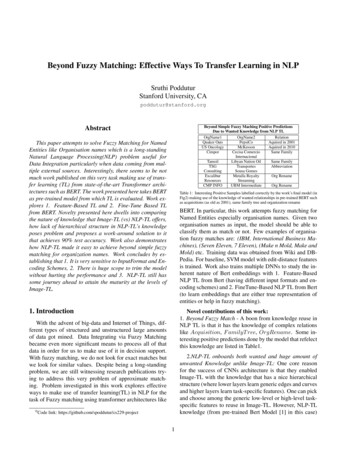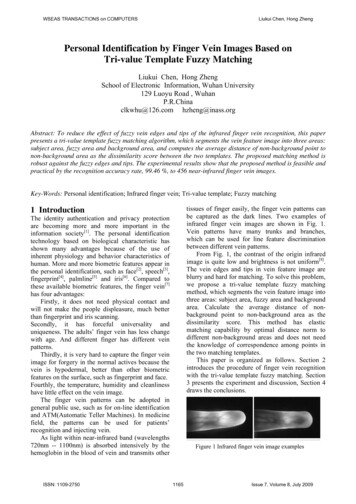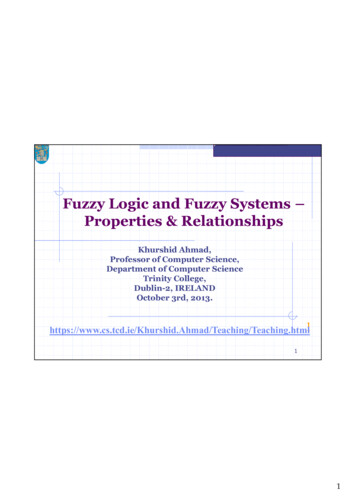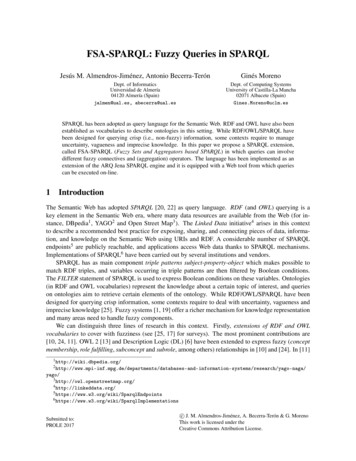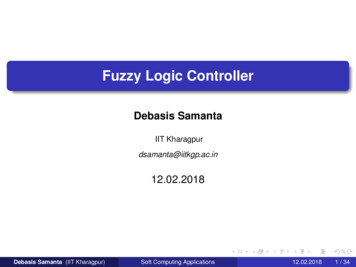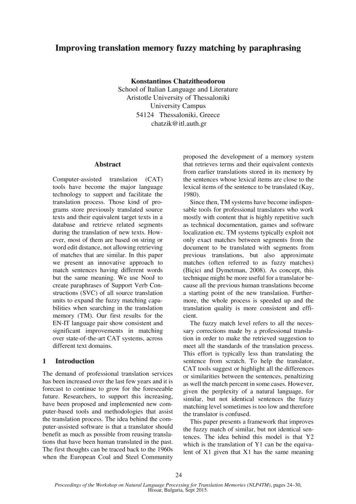
Transcription
Improving translation memory fuzzy matching by paraphrasingKonstantinos ChatzitheodorouSchool of Italian Language and LiteratureAristotle University of ThessalonikiUniversity Campus54124 Thessaloniki, Greecechatzik@itl.auth.grproposed the development of a memory systemthat retrieves terms and their equivalent contextsfrom earlier translations stored in its memory bythe sentences whose lexical items are close to thelexical items of the sentence to be translated (Kay,1980).Since then, TM systems have become indispensable tools for professional translators who workmostly with content that is highly repetitive suchas technical documentation, games and softwarelocalization etc. TM systems typically exploit notonly exact matches between segments from thedocument to be translated with segments fromprevious translations, but also approximatematches (often referred to as fuzzy matches)(Biçici and Dymetman, 2008). As concept, thistechnique might be more useful for a translator because all the previous human translations becomea starting point of the new translation. Furthermore, the whole process is speeded up and thetranslation quality is more consistent and efficient.The fuzzy match level refers to all the necessary corrections made by a professional translation in order to make the retrieved suggestion tomeet all the standards of the translation process.This effort is typically less than translating thesentence from scratch. To help the translator,CAT tools suggest or highlight all the differencesor similarities between the sentences, penaltizingas well the match percent in some cases. However,given the perplexity of a natural language, forsimilar, but not identical sentences the fuzzymatching level sometimes is too low and thereforethe translator is confused.This paper presents a framework that improvesthe fuzzy match of similar, but not identical sentences. The idea behind this model is that Y2which is the translation of Y1 can be the equivalent of X1 given that X1 has the same meaningAbstractComputer-assisted translation (CAT)tools have become the major languagetechnology to support and facilitate thetranslation process. Those kind of programs store previously translated sourcetexts and their equivalent target texts in adatabase and retrieve related segmentsduring the translation of new texts. However, most of them are based on string orword edit distance, not allowing retrievingof matches that are similar. In this paperwe present an innovative approach tomatch sentences having different wordsbut the same meaning. We use NooJ tocreate paraphrases of Support Verb Constructions (SVC) of all source translationunits to expand the fuzzy matching capabilities when searching in the translationmemory (TM). Our first results for theEN-IT language pair show consistent andsignificant improvements in matchingover state-of-the-art CAT systems, acrossdifferent text domains.1IntroductionThe demand of professional translation serviceshas been increased over the last few years and it isforecast to continue to grow for the foreseeablefuture. Researchers, to support this increasing,have been proposed and implemented new computer-based tools and methodologies that assistthe translation process. The idea behind the computer-assisted software is that a translator shouldbenefit as much as possible from reusing translations that have been human translated in the past.The first thoughts can be traced back to the 1960swhen the European Coal and Steel Community24Proceedings of the Workshop on Natural Language Processing for Translation Memories (NLP4TM), pages 24–30,Hissar, Bulgaria, Sept 2015.
with Y1. We use NooJ to create equivalent paraphrases of the source texts to improve as much aspossible the translation fuzzy match level giventhat they share the same meaning but not the samelexical items. In addition to this, we investigatethe following questions: (1) is the productivity ofthe translators improved? (2) are SVC widespreadto merit the effort to tackle them? These questionsare answered using human centralized evaluations.The rest of the paper is organized as follows:Section 2 discusses the past related work, section3 the theoretical background, section 4 the conceptual background as well the architecture of theframework. Section 5 details the experimental results and section 5 the plans for further work.2On the other hand, various researchers have focused on semantics or syntactic techniques towards improving the fuzzy matching scores in TMbut the evaluations they performed were shallowand most of the time limited to subjective evaluation by authors. Thus, this makes it hard to judgehow much a semantically informed TM matchingsystem can benefit a professional translator.Planas and Furuse (1999) propose approaches thatuse lemma and parts of speech along with surfaceform comparison. In addition to this syntactic annotation, Hodász and Pohl (2005) also includenoun phrase (NP) detection (automatic or human)and alignment in the matching process. Pekar andMitkov (2007) presented an approach based onsyntax driven syntactic analysis. Their result is ageneralized form after syntactic, lexico-syntacticand lexical generalization.Another interested approach, similar to ours,has been proposed by Gupta and Orasan (2014).In their work, they generate additional segmentsbased on the paraphrases in a database whilematching. Their approach is based on greedy approximation and dynamic programming giventhat a particular phrase can be paraphrased in several ways and there can be several possiblephrases in a segment which can be paraphrased. Itis an innovative technique, however, paraphrasinglexical or phrasal units in not always safe and insome cases, it can confuse rather than help thetranslator. In addition to this, a paraphrase database is required for each language.Even if the experimental results show significant improvements in terms of quality andproductivity, the hypotheses are produced by amachine using unsupervised methods and therefore the post-editing effort might be higher comparing to human translation hypotheses. To thebest of our knowledge, there is no similar work inliterature because our approach does not use anyMT techniques given that target side of the TMremains “as is”. To improve the fuzzy matching,we paraphrase the source translation units of theTM, so that a higher fuzzy match will be identifiedfor sentences sharing the same meaning. Therefore, the professional translator is given a humantranslated segment that is the paraphrase of thesentence to be translated. This ensures that no outof-domain lexical items or no machine translationerrors will appear in the hypotheses, making thepost-editing process trivial.Related workThere has been some work to improve the translation memory matching and retrieval of translationunits when working with CAT tools (Koehn andSenellart, 2010; He at al, 2010a; Zhechev and vanGenabith, 2010; Wang et al., 2013). Such worksaim to improve the machine translation (MT) confidence measures to better predict the human effort in order to obtain a quality estimation that hasthe potential to replace the fuzzy match score inthe TM. In addition to this, these techniques havean effect only in improvement of the MT raw output and not in improvement of fuzzy matching.A common methodology that gives priority tothe human translations is to search first formatches in the project TM. When no such closematch is found in the TM, the sentence is machine-translated (He at al, 2010a; 2010b). In asomewhat similar spirit, other hybrid methodologies combine techniques at a sub-sentential level.Most of them, use as much as possible humantranslations for a given sentence and the unmatched lexical items are machine translated inthe target language using a MT system (Smith andClark, 2009; Koehn and Senellart, 2010; He at al,2010a; Zhechev and van Genabith, 2010; Wang etal., 2013). Towards the improving of the qualityof the MT output, researchers have been using different MT approaches (statistical, rule-based orexample-based) trained either on generic or in-domain corpora. Another innovative idea has beenproposed by Dong et al. (2014). In their work,they use a lattice representation of possible translations in a monolingual target language corpus tofind the potential candidate translations.25
3paraphrased with a full verb, maintaining the samemeaning. While support verbs are similar to auxiliary verbs regarding their meaning contributionto the clauses in which they appear, support verbsfail the diagnostics that identify auxiliary verbsand are therefore distinct from auxiliaries (Butt,2003).SVCs challenge theories of compositionalitybecause the lexical items that form such constructions do not together qualify as constituents, although the word combinations do qualify as catenae. The distinction of a SVC from other complexpredicates or arbitrary verb-noun combinations isnot an easy task, especially because their syntaxthat is not always fixed. Except of some cases,they appear with direct object (e.g. to make attention) or with direct object (e.g. to make a reservation) (Athayde, 2001).Our approach paraphrases SVCs found in thesource translation units of a TM in order to increase the fuzzy matching between sentences having the same meaning. It is a safe technique because the whole process has no effect on the targetside of the TM translation units. Hence, the translators benefit only from human translation hypotheses that usually are linguistically correct.In our example, an EN-IT translator will receive an exact match during his performancewhen translating the sentence (1) given the English sentence (2) and its Italian equivalent (sentence (3)) that is included in the TM. In additionto this, in case of translating the sentence (4), thefuzzy match score would be around 90% (1 substitution for 10 words) comparing to 61% with noparaphrase (2 substitution and 3 deletions for 13words). Other than fuzzy match, according to Barreiro (2008) machine-translation of SVCs is hard,so the expected output from the machine will notbe good enough. In our example, “cancel” can beeither a verb or noun.Theoretical backgroundThere are several implementations of the fuzzymatch estimation during the translation process,and commercial products typically do not disclosethe exact algorithm they use (Koehn, 2010). However, most of them are based on the word and/orcharacter edit distance (Levenshtein distance)(Levenshtein, 1966) i.e., the total number of deletions, insertions, and substitutions in order the twosentences become identical (Hirschberg, 1997).For instance, the word-based string edit distance between sentence (1) and (2) is 70% (1 substitution and 3 deletions for 13 words), and thecharacter-based string edit distance is 76% (14 deletions for 60 characters) without countingwhitespaces based on Koehn’s (2010) formula forfuzzy matching. This is a low score and manytranslators may decide not to use it and thereforenot to gain from it.(1)Press ' Cancel ' to make the cancellation of your personalinformation .(2)(3)Press ' Cancel ' to cancel your personal information .Premere ' Cancel ' per cancellare i propri dati personali .(4)Press ' Cancel ' to cancel your booking information .In this case, according to methodologies proposed by researchers of this field, this sentencewill be sent for machine translation given the lowfuzzy match score and then it should be post-edited. Otherwise, the translator should translate itfrom scratch. However, this is not always safe,given that in many cases post-editing MT outputrequires more time than translating from scratch.Observing the differences between sentences(1) and (2) one can easily conclude that they sharethe same meaning although they don’t share thesame lexical items. This happens because of theirsyntax. In more detail, sentence (1) contains aSVC while sentence (2) contains its nominalization. An EN-IT professional translator can benefitfrom our approach by accepting the sentence (3)as the equivalent translation of the sentence (1).SVCs, like make a cancellation, are verb-nouncomplexes which occur in many languages. Forma syntactic and semantic point of view they act inthe same way as multi-word units. Their meaningis mainly reflected by the predicate noun, whilethe support verb is often semantically reduced.The support verb contributes little content to itssentence; the main meaning resides with the predicate noun (Barreiro, 2008).SVCs include common verbs like give, have,make, take, etc. Those types of complexes can be4Conceptual backgroundAs already discussed, paraphrasing a SVC can increase the fuzzy match level during the translationprocess. This section details the pipeline of modules towards the paraphrase of the TM sourcetranslation units.4.1NooJThe main component of our framework is NooJ(Silberztein, 2003). NooJ is a linguistic development environment used to construct large-coverage formalized descriptions of natural languages,and apply them to large corpora, in real time. The26
module consists of a very large lexicon, alongwith a large set of local grammars to recognizenamed entities as well as unknown words, wordsequences etc. These resources have been obtained from OpenLogos, an old open source rulebased MT system (Scott and Barreiro, 2009). InNooJ, an electronic dictionary contains the lemmas with a set of information such as the category/part-of-speech (e.g. V for verbs, A for adjectives etc.), one or more inflectional and/or derivational paradigms (e.g. how to conjugate verbs,how to lemmatize or nominalize them etc.), one ormore syntactic properties (e.g. transitiv for transitive verbs or PREPin etc.), one or more semantic properties (e.g. distributional classes such as Human, domain classes such as Politics) andfinally, one or more equivalent translations( IT “translation equivalent”). Figure 1 illustrates typical dictionary entries.(Petrov et al., 2006). The same tool is also usedfor the de-tokenization process in the last step.Then, all the source translation units passthrough NooJ to identify the SVCs using the localgrammar of Figure 3. To do so, NooJ first pre-processes and analyses the text based on specific dictionaries and grammars attached in the module.This is a crucial step because if the text is not correctly analyzed, the local grammar will not identify all the potential SVCs and therefore there willnot be any gain in terms of fuzzy matching. Oncethe text is analyzed, all the possible SVCs areidentified and hence paraphrased.artist,N FLX TABLE Humcousin,N FLX TABLE Humpen,N FLX TABLE Conctable,N FLX TABLE Concman,N FLX MAN HumFigure 1: Dictionary entries in NooJ for nouns.4.2Paraphrasing the source translationunitsFigure 3: Local grammar for identification and paraphrasing of SVCs.The generation of the TM that contains the paraphrased translation units is straightforward. Thearchitecture of the process which is summarizedin Figure 2, is performed in three pipelines:In more detail, the local grammar checks for asupport verb followed by a determiner, adjectiveor adverb (optionally), a nominalization and optionally by a preposition, and generates the verbalparaphrases in the same tense and person as thesource. We should notice that this graph recognizes and paraphrases only SVCs in simple present indicative tense. However, our NooJ modulecontains grammars created for the all the othergrammatical tenses and moods that follow thesame structure. The elements in red colors characterize the variables as verb and predicate nouns.Theelements V : V PR 1 s ,and N PR 1 s represent lexical constraints that aredisplayed in the output, such as specification ofthe support verb that belongs to a specific SVC.These particular elements refer to the first personsingular of the simple present tense. The predicatenoun is identified, mapped to its deriver and displayed as a full verb while the other elements ofthe sentence are eliminated. The final output ofNooJ is a sentence that contains the paraphrase instead of the SVCs, were applicable.The last pipeline contains the de-tokenizationas well as the concatenation of the paraphrasedFigure 2: Pipeline of the paraphrase framework.The first pipeline includes the extraction of thesource translation units of a given TM. The targettranslation units are protected so that they will notbe parsed by the framework. This step also includes the tokenization process. Tokenization ofthe English data is done using Berkeley Tokenizer27
translation units in the original TM, if any. Theparaphrased translation units have the same proprietaries, tags etc., as the original units.This TM should be imported and used in thesame way as before in all CAT tools. As of now,our approach can be applied only to TMs that havethe English language as source. As mentioned earlier, there is no limit for the target language giventhat we apply our approach only to the source language translation units.5Fuzzy matchcategory100%95% - 99%85% - 94%75% - 84%50% - 74%No MatchTotalExperimental resultsplTM parTM142318513262200483229381835200Table 1: Statistics for experimental dataThe aim of this research is to provide translatorswith fuzzy match scores higher than before in casethe TM contains a translation unit which has thesame meaning with the sentence to be translated.Given that there is no automatic evaluation for thispurpose, we formulate this as a ranking problem.In this work, we analyze a set of 100 sentencesfrom automotive domain and 100 from IT domainto measure the difference of the fuzzy matchscores between our approach (parTM) and theconversional translation process, where a plainTM is used (plTM). This test set, was selectedmanually in order to contain SVCs in order to ensure that each sentence contains at least one SVC.Our method has been applied to a TM whichcontained 1025 EN-IT translation units. Our module recognized 587 SVCs, so the generated TM(parTM) was contained 1612 translation units(1025 original 587 paraphrases). The TM contains translations that have been taken from alarger TM based on the degree of fuzzy match thatat least meets the minimum threshold of 50%. Tocreate the analysis report logs we used Trados Studio 20141.The results of both analyses are given in Table1.Our paraphrased TM attains state-of-the-artperformance on increasing the fuzzy match leveraging. It is interesting to note that the highestgains are achieved in the low fuzzy categories(0%-74%). However, we achieve extremely highnumbers in other categories. Our approach improves the scores by 17% in 100% match category, 5% in category 95% - 99%, 6% in category85% - 94%, 28% in category 75% - 84% and finally, 27% in category 0%-74% (No match 50%-74%). This is a clear indication that paraphrasing of SVCs significantly improves the retrieval results and hence the productivity.To check the quality of the retrieved segmentshuman judgment was carried by professionaltranslators. The test set consist of retrieved segments with fuzzy match score 85% (108 segments). The motivation for this evaluation is twofold. Firstly to show how much impact paraphrasing of SVCs has in terms of retrieval and secondlyto see the translation quality of those segmentswhich the fuzzy match score is improved becauseof the paraphrasing process.According to translators, paraphrasing helpsand speeds up the translation process. Moreover,the fact that the target segments remain “as is” encourage them to use it without a second thought.Figure 4 shows two cases where translators selected to use segments from the parTM. We cansee that paraphrasing not only helps to increasethe retrieving but also ensures that the proposedtranslation is a human translation, so no errors willappear and less post editing is required in case ofnot equal to 100%.While there are some drops in terms of fuzzymatch improvement, our system presents fewweaknesses. Most of them regard the out-of-vocabulary words during the analysis process byNooJ. Although our NooJ module contains a verylarge lexicon, along with a very large set of localgrammars to recognize and paraphrase SVCs, afew translation units (6 segments) were not paraphrased. In addition to this, 2 segments were paraphrased incorrectly. This happens because theycontain either out-of-vocabulary words or due totheir syntax complexity. This is one of our approach’s weaknesses that will be addressed for future ionproductivity/trados-studio/28Seg:Make sure that the brake hose is not twisted.TMsl:TMtgEnsure that the brake hose is not twistedAssicurarsi che il tubo flessibile freni non sia attorcigliato.
parTMsl:Make sure that the brake hose is not twisted.Seg:CAUTION: You must make the istallation of theversion 6 of the software.TMsl:CAUTION: You must install the version 6 of thesoftware.ATTENZIONE: Si deve installare la versione 6del software.TMtgparTMslComputational Linguistics (CICLing 2008), LNCS,Haifa, Israel, February 2008.But M. 2003. The Light Verb Jungle. In Harvard Working Papers in Linguistics, ed. G. Aygen, C. Bowern,and C. Quinn. 1–49. Volume 9, Papers from theGSAS/Dudley House workshop on light verbs.Dong M., Cheng Y., Liu Y., Xu J., Sun M., Izuha T.,and Hao J. 2014. Query lattice for translation retrieval. In COLING.CAUTION: You must make the istallation of theversion 6 of the software.Gupta R. and Orasan C. 2014. Incorporating Paraphrasing in Translation Memory Matching and Retrieval. In Proceedings of the 17th Annual Conference of European Association for Machine Translation.Figure 4: Accepted translations.6ConclusionHe Y., Ma Y., van Genabith J., and Way A. 2010a.Bridging SMT and TM with translation recommendation. In ACL.In this paper, we have presented a method that improves the fuzzy match of similar, but not identical sentences. We use NooJ to create equivalentparaphrases of the source texts to improve asmuch as possible the translation fuzzy match levelgiven that the meaning is the same but they don’tshare the same lexical items.The hybridization strategy implemented has already been evaluated with different experiments,translators, text types and language pairs, whichshowed that it is very effective. The results showthat for all fuzzy-match ranges our approach performs markedly better than the plain TM for different fuzzy match levels, especially for low fuzzymatch categories. In addition to this, the translators’ satisfaction and trust is abundant comparingto MT approaches.In the future, we will continue to explore waysparaphrasing of other support verbs and other support languages as well. Last but not least, a paraphrase framework to the target sentence may improve even more the quality of translations.He Y., Ma Y., Way A., and Van Genabith J. 2010b.Integrating n-best SMT outputs into a TM system. InCOLING.Hirschberg Daniel S. 1997. Serial computations of Levenshtein distances. Pattern matching algorithms,Oxford University Press, Oxford.Hodász G., & Pohl G. 2005. MetaMorpho TM: a linguistically enriched translation memory. In In international workshop, modern approaches in translation technologies.Kay M. 1980. The proper place of men and machinesin language translation. Palo Alto, CA: Xerox PaloAlto Research Center, October 1980; 21pp.Koehn P. and Senellart J. 2010. Convergence of translation memory and statistical machine translation.In AMTA.Levenshtein Vladimir I. 1966. Binary codes capable ofcorrecting deletions, insertions, and reversals. InSoviet physics doklady, volume 10, pages 707–710.Pekar V., & Mitkov R. 2007. New Generation Translation Memory: Content-Sensivite Matching. In Proceedings of the 40th anniversary congress of theswiss association of translators, terminologists andinterpreters.ReferencesAthayde M. F. 2001. Construções com verbo-suporte(funktionsverbgefüge) do português e do alemão. InCadernos do CIEG Centro Interuniver-sitário de Estudos Germanísticos. n. 1. Coimbra, Portugal: Universidade de CoimbraPetrov S., Leon B., Romain T, and Dan K. 2006.Learning accurate, compact, and interpretable treeannotation. In Proceedings of the COLING/ ACL,pages 433–440.Barreiro A. 2008. Make it simple with paraphrases:Automated paraphrasing for authoring aids andmachine translation. Ph. D. thesis, Universidate doPortoPlanas E., & Furuse O. 1999. Formalizing TranslationMemories. In Proceedings of the 7th machine translation summit (pp. 331–339).Biçici E and Dymetman M 2008. Dynamic Translation Memory: Using Statistical Machine Translation to improve Translation Memory FuzzyMatches. In Proceedings of the 9th InternationalConference on Intelligent Text Processing andScott B, Barreiro A 2009. Openlogos MT and the SALrepresentation language. In: Proceedings of the firstinternational workshop on free/open-source rulebased machine translation, Alacant, pp 19–2629
Silberztein M. 2003. NooJ manual. Available athttp://www.nooj4nlp.netSmith J. and Clark S. 2009. Ebmt for SMT: A newEBMT-SMT hybrid. In EBMT.Wang K., Zong C., and Su K.-Y. 2014. Dynamicallyintegrating cross-domain translation memory intophrase-based machine translation during decoding.In COLING.Zhechev V. and van Genabith J. 2010. Seeding statistical machine translation with translation memoryoutput through tree-based structural alignment. InSSST.30
remains ³as is . To improve the fuzzy matching, we paraphrase the source translation units of the TM, so that a higher fuzzy match will be identified for sentences sharing the sa me meaning. There-fore, the prof essional translato r is given a human translated segment that is the paraphrase of the sentence to be translated.
